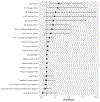Factors associated with falls in older adults: A secondary analysis of a 12-month randomized controlled trial
- PMID: 36709562
- PMCID: PMC10068618
- DOI: 10.1016/j.archger.2023.104940
Factors associated with falls in older adults: A secondary analysis of a 12-month randomized controlled trial
Abstract
Purpose: While identifying older adults at risk for falls is important, fall prediction models have had limited success, in part because of a poor understanding of which physical function measures to include. The purpose of this secondary analysis was to determine physical function measures that are associated with future falls in older adults.
Methods: In a 12-month trial comparing Vitamin D3 supplementation versus placebo on neuromuscular function, 124 older adults completed physical function measures at baseline, including the Short Physical Performance Battery (SPPB), Timed Up and Go, tests of leg strength and power, standing balance on a force plate with firm and foam surfaces, and walking over an instrumented walkway. Falls were recorded with monthly diaries over 12 months and categorized as no falls vs. one or more falls. Univariate and multivariable logistic regression adjusting for demographics, treatment assignment, depression, and prescription medications were conducted to examine the association between each physical function measure and future falls. Models were additionally adjusted for fall history.
Results: 61 participants sustained one or more falls. In univariate analysis, white race, depression, fall history, SPPB, and postural stability on foam were significantly associated with future falls. In multivariable analysis, fall history (OR (95% CI): 3.20 (1.42-7.43)), SPPB (0.80 (0.62-1.01)), and postural stability on foam (3.01 (1.18, 8.45)) were each significantly associated with future falls. After adjusting for fall history, only postural stability on foam was significantly associated with falls.
Conclusions: When developing fall prediction models, fall history, the SPPB, and postural stability when standing on foam should be considered.
Keywords: Gait; Logistic regression; Model; Physical function; Physical performance; Postural stability.
Copyright © 2023. Published by Elsevier B.V.
Conflict of interest statement
Declaration of Competing Interest All authors have no conflicts of interest.
Figures


References
-
- Kempen GI, van Haastregt JC, McKee KJ, Delbaere K, Zijlstra GA. Socio-demographic, health-related and psychosocial correlates of fear of falling and avoidance of activity in community-living older persons who avoid activity due to fear of falling. BMC Public Health. Jun 2 2009;9:170. doi:10.1186/1471-2458-9-170 - DOI - PMC - PubMed
Publication types
MeSH terms
Grants and funding
LinkOut - more resources
Full Text Sources

